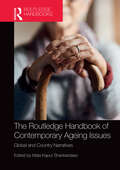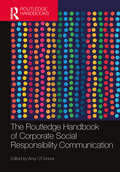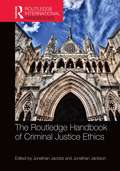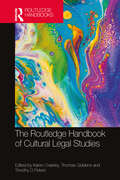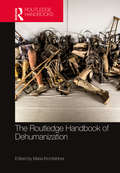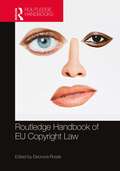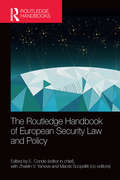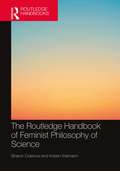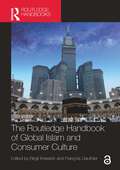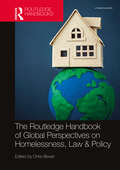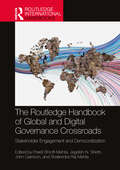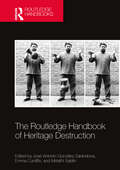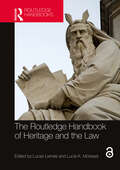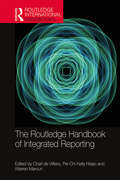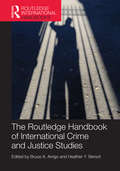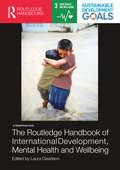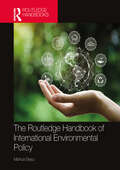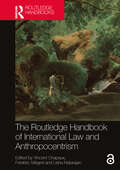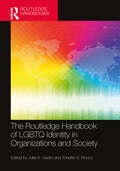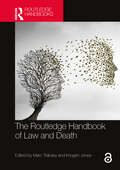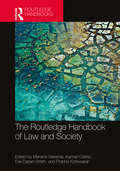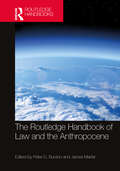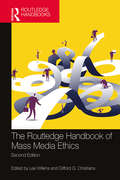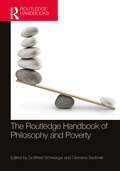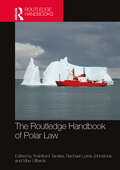- Table View
- List View
The Routledge Handbook of Contemporary Ageing Issues: Global and Country Narratives
by Mala Kapur ShankardassThis handbook provides a comprehensive look into the emerging issues confronting ageing societies across the world. Drawing on scholarship from Africa, the Americas, Asia Pacific and Europe, it explores different dimensions of ageing, gender, health, environment, care, elder abuse, generational relationships, and grief.The volume adopts a gerontological perspective to evaluate ageing-specific policies and places emphasis on guiding research and practice towards achieving a better quality of life for older people across the world. It argues that new developments because of changing age structures, support ratios, family relationships and socioeconomic situations call for innovative practices, in terms of health and social care facilities, livelihood opportunities, retirement options, skill development and educational learning.Lucid and accessible, the handbook will be of interest to those working in gerontology, ageing, health, death studies, social care, public health policy, human rights law, sociology and social policy, gender studies, cultural studies, medical sociology, political sociology, mental health, and social sciences.
The Routledge Handbook of Corporate Social Responsibility Communication (Routledge Handbooks in Communication Studies)
by Amy O’ConnorThis handbook is a resource for students, faculty, and researchers who are focused on understanding the role communication plays in the formation and execution of corporate social responsibility (CSR) activities. Bringing together authors who are thought-leaders and emerging scholars from diverse theoretical and methodological perspectives, it examines the issues central to CSR communication including: theoretical underpinnings, form and content of CSR messaging, the boundaries of engagement, and the tensions associated with CSR communication. It offers a unique combination of functional and formative approaches to CSR communication designed to expose readers to a blend of approaches. With attention to issues of diversity, equity, and inclusion, this handbook also explicitly addresses recent societal changes and how those changes will impact CSR communication research and practices in the future. Offering both a strong introduction to topics for novices as well as a more advanced interrogation of CSR communication for more knowledgeable readers, the handbook is appropriate for advanced students and researchers in public relations, strategic communication, organizational communication, and allied fields.
The Routledge Handbook of Criminal Justice Ethics (Routledge International Handbooks)
by Jonathan Jacobs Jonathan JacksonThe enormous financial cost of criminal justice has motivated increased scrutiny and recognition of the need for constructive change, but what of the ethical costs of current practices and policies? Moreover, if we seriously value the principles of liberal democracy then there is no question that the ethics of criminal justice are everybody’s business, concerns for the entire society. The Routledge Handbook of Criminal Justice Ethics brings together international scholars to explore the most significant ethical issues throughout their many areas of expertise, anchoring their discussions in the empirical realities of the issues faced rather than applying moral theory at a distance. Contributions from philosophers, legal scholars, criminologists and psychologists bring a fresh and interdisciplinary approach to the field. The Handbook is divided into three parts: Part I addresses the core issues concerning criminal sanction, the moral and political aspects of the justification of punishment, and the relationship between law and morality. Part II examines criminalization and criminal liability, and the assumptions and attitudes shaping those aspects of contemporary criminal justice. Part III evaluates current policies and practices of criminal procedure, exploring the roles of police, prosecutors, judges, and juries and suggesting directions for revising how criminal justice is achieved. Throughout, scholars seek pathways for change and suggest new solutions to address the central concerns of criminal justice ethics. This book is an ideal resource for upper-undergraduate and postgraduate students taking courses in criminal justice ethics, criminology, and criminal justice theory, and also for students of philosophy interested in punishment, law and society, and law and ethics.
The Routledge Handbook of Cultural Legal Studies
by Thomas Giddens Karen Crawley Timothy D PetersThis handbook provides a comprehensive introduction to the cutting-edge field of cultural legal studies.Cultural legal studies is at the forefront of the legal discipline, questioning not only doctrine or social context, but how the concerns of legality are distributed and encountered through a range of material forms. Growing out of the interdisciplinary turn in critical legal studies and jurisprudence that took place in the latter quarter of the 20th century, cultural legal studies exists at the intersection of a range of traditional disciplinary areas: legal studies, cultural studies, literary studies, jurisprudence, media studies, critical theory, history, and philosophy. It is an area of study that is characterised by an expanded or open-ended conception of what ‘counts’ as a legal source, and that is concerned with questions of authority, legitimacy, and interpretation across a wide range of cultural artefacts. Including a mixture of established and new authors in the area, this handbook brings together a complex set of perspectives that are representative of the current field, but which also address its methods, assumptions, limitations, and possible futures.Establishing the significance of the cultural for understanding law, as well as its importance as a potential site for justice, community, and sociality in the world today, this handbook is a key reference point both for those working in the cultural legal context – in legal theory, law and literature, law and film/television, law and aesthetics, cultural studies, and the humanities generally – as well as others interested in the interactions between authority, culture, and meaning.
The Routledge Handbook of Dehumanization (Routledge Handbooks in Philosophy)
by Maria KronfeldnerA striking feature of atrocities, as seen in genocides, civil wars, or violence against certain racial and ethnic groups, is the attempt to dehumanize — to deny and strip human beings of their humanity. Yet the very nature of dehumanization remains relatively poorly understood.The Routledge Handbook of Dehumanization is the first comprehensive and multidisciplinary reference source on the subject and an outstanding survey of the key concepts, issues, and debates within dehumanization studies. Organized into four parts, the Handbook covers the following topics: The history of dehumanization from Greek Antiquity to the 20th century, contextualizing the oscillating boundaries, dimensions, and hierarchies of humanity in the history of the ‘West’; How dehumanization is contemporarily studied with respect to special contexts: as part of social psychology, as part of legal studies or literary studies, and how it connects to the idea of human rights, disability and eugenics, the question of animals, and the issue of moral standing; How to tackle its complex facets, with respect to the perpetrator’s and the target’s perspective, metadehumanization and selfdehumanization, rehumanization, social death, status and interdependence, as well as the fear we show toward robots that become too human for us; Conceptual and epistemological questions on how to distinguish different forms of dehumanization and neighboring phenomena, on why dehumanization appears so paradoxical, and on its connection to hatred, essentialism, and perception. Essential reading for students and researchers in philosophy, history, psychology, and anthropology, this Handbook will also be of interest to those in related disciplines, such as politics, international relations, criminology, legal studies, literary studies, gender studies, disability studies, or race and ethnic studies, as well as readers from social work, political activism, and public policy.
The Routledge Handbook of EU Copyright Law
by Eleonora RosatiThe Routledge Handbook of EU Copyright Law provides a definitive survey of copyright harmonization in the European Union, capturing the essential and relevant issues of this relatively recent phenomenon. Over the past few years, two themes have emerged: on the one hand, copyright policy and legislative initiatives have intensified; on the other hand, the large number of references to the Court of Justice of the European Union has substantially shaped the EU copyright framework and, with it, the copyright framework of individual EU Member States. This handbook is a detailed reference source of original contributions which analyze and critically evaluate the state of EU copyright law with a view to detecting the key trends and patterns in the evolution of EU copyright, weighing the benefits and disadvantages of such evolution. It covers a broad range of topics through clusters focused on: the history and approaches to EU copyright harmonization; harmonization in the areas of exclusive rights, exceptions and limitations, and enforcement; copyright policy and legacy of harmonization. With contributions from a selection of highly regarded and leading scholars in this field, the Routledge Handbook on European Copyright Law is an essential resource for students and scholars who are interested in the field of copyright law.
The Routledge Handbook of European Security Law and Policy
by Marzia Scopelliti E. CondeThe Handbook of European Security Law and Policy offers a holistic discussion of the contemporary challenges to the security of the European Union and emphasizes the complexity of dealing with these through legislation and policy. Considering security from a human perspective, the book opens with a general introduction to the key issues in European Security Law and Policy before delving into three main areas. Institutions, policies and mechanisms used by Security, Defence Policy and Internal Affairs form the conceptual framework of the book; at the same time, an extensive analysis of the risks and challenges facing the EU, including threats to human rights and sustainability, as well as the European Union’s legal and political response to these challenges, is provided. This Handbook is essential reading for scholars and students of European law, security law, EU law and interdisciplinary legal and political studies.
The Routledge Handbook of Feminist Philosophy of Science (Routledge Handbooks in Philosophy)
by Sharon CrasnowThe Routledge Handbook of Feminist Philosophy of Science is a comprehensive resource for feminist thinking about and in the sciences. Its 33 chapters were written exclusively for this Handbook by a group of leading international philosophers as well as scholars in gender studies, women’s studies, psychology, economics, and political science.The chapters of the Handbook are organized into four main parts: I. Hidden Figures and Historical CritiqueII. Theoretical FrameworksIII. Key Concepts and IssuesIV. Feminist Philosophy of Science in Practice.The chapters in this extensive, fourth part examine the relevance of feminist philosophical thought for a range of scientific and professional disciplines, including biology and biomedical sciences; psychology, cognitive science, and neuroscience; the social sciences; physics; and public policy. The Handbook gives a snapshot of the current state of feminist philosophy of science, allowing students and other newcomers to get up to speed quickly in the subfield and providing a handy reference for many different kinds of researchers.
The Routledge Handbook of Global Islam and Consumer Culture (Routledge Handbooks in Religion)
by Birgit Krawietz François GauthierThe Routledge Handbook of Global Islam and Consumer Culture is an outstanding inter- and transdisciplinary reference source to key topics, problems, and debates in this challenging research field. The study of Islam is enriched by investigating religion and, notably, Islamic normativity (fiqh) as a resource for product design, attitudes toward commodification, and appropriated patterns of behavior. Comprising 35 chapters (including an extended Introduction) by a team of international contributors from chairholders to advanced graduate students, the handbook is divided into seven parts: Guiding Frameworks of Understanding Historical Probes Urbanism and Consumption Body Manipulation, Vestiary Regimes, and Gender Mediated Religion and Culture Consumer Culture, Lifestyle, and Senses of the Self through Consumption Markets These sections examine vibrant debates around consumption, frugality, Islamic jurisprudence and fatwas in the world economy, capitalism, neoliberalism, trade relations, halalization, (labor) tourism and travel infrastructure, body modification, fashion, self-fashioning, lifestylization, Islamic kitsch, urban regeneration, heritage, Islamic finance, the internet, and Quran recitation versus music. Contributions present selected case studies from countries across the world, including China, Indonesia, Malaysia, Morocco, Nigeria, Qatar, Pakistan, and Turkey.The handbook is essential reading for students and researchers in Islamic studies, Near and Middle Eastern studies, religious studies, and cultural studies. The handbook will also be very useful for those in related fields, such as politics, area studies, sociology, anthropology, and history.Chapter 11 of this book is freely available as a downloadable Open Access PDF at http://www.taylorfrancis.com under a Creative Commons [Attribution-Non Commercial-No Derivatives (CC BY-NC-ND) 4.0 license.
The Routledge Handbook of Global Perspectives on Homelessness, Law & Policy
by Chris BevanThis handbook provides a comprehensive global survey and assessment of the law and policy relating to homelessness prevention. Homelessness is regarded internationally as one of the most pressing issues facing humanity and one of the greatest social challenges of our times. This has been further amplified as a result of the Covid-19 pandemic. Across the globe, there is an enormous divergence in both experiences of and responses to homelessness from governments and state actors. This handbook examines how different jurisdictions from across all five continents of the world have encountered, framed and responded to homelessness. Written by expert scholars and leaders in their field, the book engages in a multidisciplinary and comparative analysis of homelessness as an issue of acute social concern. Understandings of homelessness are geographically, culturally and historically situated, making analysis of each jurisdiction’s approach by a national expert deeply insightful. The collection examines legal and extra-legal policy interventions targeted at reducing or preventing homelessness from across the globe. Drawing on diverse perspectives, differing cultures and welfare regimes, it thus constitutes a timely evaluation of current approaches to homelessness internationally. This book will appeal to students and scholars of homelessness, sociology, social policy, anthropology, and urban sociology, as well as international and national policymakers.
The Routledge Handbook of Global and Digital Governance Crossroads: Stakeholder Engagement and Democratization
by Jagdish N. Sheth Preeti Shroff-Mehta John Garrison Shailendra Raj MehtaThis handbook maps and analyzes cross-sector (public–corporate–social–community–faith) governance theories, models, and practices as they are evolving in a digital world. It studies human, cultural, societal, institutional interactions and challenges in a digitally enabled world, especially in the context of post-crisis resilience and agility. Every global crisis forces societies and nations to realign while addressing deeper structural and cultural issues in governance. The Covid-19 pandemic has necessitated swift local-to-global governance responses for timely digital innovations for health crisis interventions, economic recovery, and societal equity. While every nation-state is developing global pandemic responses in a digitally enabled world, the deeper crisis of human, institutional, and societal governance deficit is also evident. This handbook documents digital governance innovations that enhance stakeholder engagement and inclusion for resilient, accountable, and effective governance across sectors. This volume reflects on a range of theoretical frameworks adapted for understanding global and digital governance. It looks at international governance collaborations; corporate governance reform; education governance innovations; public sector and urban governance; health system governance, sustainability, and environmental governance; community and faith-based governance; and digital, cultural, and creativity governance. This book is unique, as it presents important work on post Covid-19 digital and democratic governance and brings together holistic—interdisciplinary and intersectoral— perspectives from the Global North and Global South, engaging the leading scholars, practitioners, businesses, and civil society. It will be of interest to multi-sector institutions and global audiences: governments, corporates, social sector institutions, digital entrepreneurs, students and researchers, academic professionals, policy-makers, public and private sector institutional leaders, and organizational and entrepreneurial innovators interested in the field of governance.
The Routledge Handbook of Heritage Destruction (Routledge Handbooks on Museums, Galleries and Heritage)
by Emma Cunliffe Melathi Saldin Zarandona, José Antonio GonzálezThe Routledge Handbook of Heritage Destruction presents a comprehensive view on the destruction of cultural heritage and offers insights into this multifaceted, interdisciplinary phenomenon; the methods scholars have used to study it; and the results these various methods have produced. By juxtaposing theoretical and legal frameworks and conceptual contexts alongside a wide distribution of geographical and temporal case studies, this book throws light upon the risks, and the realizations, of art and heritage destruction. Exploring the variety of forces that drive the destruction of heritage, the volume also contains contributions that consider what forms heritage destruction takes and in which contexts and circumstances it manifests. Contributors, including local scholars, also consider how these drivers and contexts change, and what effect this has on heritage destruction, and how we conceptualise it. Overall, the book establishes the importance of the need to study the destruction of art and cultural heritage within a wider framework that encompasses not only theory but also legal, military, social, and ontological issues. The Routledge Handbook of Heritage Destruction will contribute to the development of a more complete understanding and analysis of heritage destruction. The Handbook will be useful to academics, students, and professionals with interest in heritage, conservation and preservation, history and art history, archaeology, anthropology, philosophy, and law.
The Routledge Handbook of Heritage and the Law (Routledge Handbooks on Museums, Galleries and Heritage)
by Lucas Lixinski Lucie K. MorissetThe Routledge Handbook of Heritage and the Law sheds light on the relationship between the two fields and analyses how the law shapes heritage and heritage practice in both expected and unexpected ways.Including contributions from 41 authors working across a range of jurisdictions, the volume analyses the law as a transnational phenomenon and uses international and comparative legal methodologies to distil lessons for broad application. Demonstrating that the law is fundamentally a language of power and contestation, the Handbook shows how this impacts our views of heritage. It also shows that, to understand the ways in which the law impacts key aspects of heritage practice, it is important to tap into the possibilities of heritage as points of convergence of identity, struggles over resources, and the distribution of power. Framing heritage as a driver for legal engagement rather than a passive regulatory object, the book first reviews the legal fields or mechanisms that can shape action in the heritage field, then questions how these enable authority and give power to those who seize heritage, and finally envisions how the discussion between heritage and the law can lay new grounds in both those fields. Lifting the mists that often render the law opaque in heritage studies, the Handbook showcases the law as a medium through which the culture and the power of heritage are expressed and might be shared.The Routledge Handbook of Heritage and the Law presents a view of the law that is aimed at those who wish to reflect on how law has changed, or could change, what heritage is and how it can support social, cultural, local, or other development. It will be of interest to scholars, students, policymakers, and practitioners working in the areas of museum studies, heritage studies, and urban studies, as well as in cultural intervention and planning.Chapter 8 of this book is freely available as a downloadable Open Access PDF at http://www.taylorfrancis.com under a Creative Commons Attribution-Non Commercial-No Derivatives (CC-BY-NC-ND) 4.0 license.Chapter 18 of this book is freely available as a downloadable Open Access PDF at http://www.taylorfrancis.com under a Creative Commons Attribution-Non Commercial-No Derivatives (CC-BY-NC-ND) 4.0 license.Chapter 34 of this book is freely available as a downloadable Open Access PDF at http://www.taylorfrancis.com under a Creative Commons (CC-BY) 4.0 license.The Routledge Handbook of Heritage and the Law | Lucas Lixinski, Lucie (taylorfrancis.com)
The Routledge Handbook of Integrated Reporting (Routledge International Handbooks)
by Charl De VilliersThis timely handbook provides a current and comprehensive examination of integrated reporting, both practical and research-based. It offers insights and different perspectives from more than 60 authors, including representatives of the International Integrated Reporting Council, Integrated Reporting Committee of South Africa, professional bodies and audit firms, as well as leading academics in the fields of integrated reporting, sustainability reporting and corporate social responsibility. This collected work provides an in-depth review of the development of integrated reporting, with a focus on the interpretation and guidance provided by the International Integrated Reporting Council. It encourages the development of new thinking and research topics in the area of integrated reporting (such as links between integrated reporting and reports focused on financial and corporate social responsibility matters), as well as showcasing how integrated reporting issues are seen and practiced in different parts of the world. The chapters include reviews of the most recent research, practitioner viewpoints, conceptual pieces, case studies and disclosure analyses. Accessible and engaging, this handbook will be an invaluable overview for those new to the field or those who are interested in ensuring they are up to date with its developments, as well as those who are concerned with how to construct an integrated report.
The Routledge Handbook of International Crime and Justice Studies (Routledge International Handbooks)
by Bruce A. Arrigo Heather Y. BersotThe Routledge Handbook of International Crime and Justice Studies presents the enduring debates and emerging challenges in crime and justice studies from an international and multi-disciplinary perspective. Guided by the pivotal, although vastly under-examined, role that consumerism, politics, technology, and culture assume in shaping these debates and in organizing these challenges, individual chapters probe the global landscape of crime and justice with astonishing clarity and remarkable depth. A distinguished collection of experts examine the interdisciplinary field of international crime and justice. Their contributions are divided into thematic sections, including: theory, culture, and society industries of crime and justice: systems of policing, law, corrections and punishment the criminal enterprise global technologies media, crime, and culture green criminology political violence public health criminology the political economy of crime and justice. All the chapters include full pedagogy and instructional resources for easy referencing or classroom use. This Handbook will be useful for students, scholars and practitioners of law, medicine, history, economics, sociology, politics, philosophy, education, public health, and social policy.
The Routledge Handbook of International Development, Mental Health and Wellbeing
by Laura DavidsonMental health has always been a low priority worldwide. Yet more than 650 million people are estimated to meet diagnostic criteria for common mental disorders such as depression and anxiety, with almost three-quarters of that burden in low- and middle-income countries. Nowhere in the world does mental health enjoy parity with physical health. Notwithstanding astonishing medical advancements in treatments for physical illnesses, mental disorder continues to have a startlingly high mortality rate. However, despite its widespread neglect, there is now an emerging international imperative to improve global mental health and wellbeing. The UN’s current international development agenda finalised at the end of 2015 contains 17 Sustainable Development Goals (SDGs), including SDG3, which seeks to ensure healthy lives and promote wellbeing for all at all ages. Although much broader in focus than the previous eight Millennium Development Goals (MDGs), the need for worldwide improvement in mental health has finally been recognised. This Handbook addresses the new UN agenda in the context of mental health and sustainable development, examining its implications for national and international policy-makers, decision-makers, researchers and funding agencies. Conceptual, evidence-based and practical discussions crossing a range of disciplines are presented from the world’s leading mental health experts. Together, they explore why a commitment to investing in mental health for the fulfilment of SDG3 ought to be an absolute global priority.
The Routledge Handbook of International Environmental Policy
by Mahua BasuThis handbook is a one-stop, comprehensive guide to global initiatives for climate action. It examines policies to tackle climate change and the critical role various organizations play.The volume: Includes in-depth discussion of individual issues related to the environment Highlights global initiatives, negotiations, and international organizations responsible for climate action, protecting marine and freshwater environment, protecting atmosphere and climate, conserving biological diversity, chemicals and wastes management, environmental governance, safeguarding against warfare and disasters Debates on-ground implications of the international policies for the Global South Brings together case studies from across the world Presents a toolkit for environment practitioners to seek sustainable and practicable solutions to problems Includes suggested readings for researchers Brings together primary documents, supportive illustrations, graphs, and maps The handbook will be an essential reference for scholars and researchers of environmental studies, environmental policy and governance, sustainability and resilience. It will also be indispensable for policy makers, think tanks and NGOs.
The Routledge Handbook of International Law and Anthropocentrism
by Vincent Chapaux, Frédéric Mégret and Usha NatarajanThis handbook explores, contextualises and critiques the relationship between anthropocentrism – the idea that human beings are socially and politically at the centre of the cosmos – and international law. While the critical study of anthropocentrism has been under way for several years, it has either focused on specific subfields of international law or emanated from two distinctive strands inspired by the animal rights movement and deep ecology. This handbook offers a broader study of anthropocentrism in international law as a global legal system and academic field. It assesses the extent to which current international law is anthropocentric, contextualises that claim in relation to broader critical theories of anthropocentrism, and explores alternative ways for international law to organise relations between humans and other living and non-living entities. This book will interest international lawyers, environmental lawyers, legal theorists, social theorists, and those concerned with the philosophy and ethics of ecology and the non-human realms.
The Routledge Handbook of LGBTQ Identity in Organizations and Society (Routledge International Handbooks)
by Tonette S. Rocco Julie A. GedroSexuality, gender, gender identity, and gender expression are fluid constructs, and the ways in which identity development intersects with organizations and exists in society are complex. The book is comprised of a range of multi-disciplinary and globally inspired perspectives representing leading-edge scholarship by authors from over a dozen countries on a range of issues and contexts regarding LGBTQ identity and experience. It is intended for a wide readership: those who are in LGBTQ-related academic fields; those who want to broaden their coursework by offering supplemental readings that center the perspectives of LGBTQ identities; and those who want to acquire knowledge and education on the subject of LGBTQ identity. There are 36 chapters written by scholars in fields such as social work, law, queer studies, business, human resource management and development, entrepreneurship, criminal justice, economics, marketing, religion, architecture, sport, theater, psychology, human ecology, and adult education. The chapters can be read in sequence, and the book can also be used as a reference work for which educators, practitioners, and non-academics can identify and select particular chapters that inform areas of inquiry.
The Routledge Handbook of Law and Death
by Marc TrabskyThe Routledge Handbook of Law and Death provides a comprehensive survey of contemporary scholarship on the intersections of law and death in the 21st century.It showcases how socio-legal scholars have contributed to the critical turn in death studies and how the sociology of death has impacted upon the discipline of law. In bringing together prominent academics and emerging experts from a diverse range of disciplines, the Handbook shows how, far from shunning questions of mortality, legal institutions incessantly talk about death. Touching upon the epistemologies and materialities of death, and problems of contested deaths and posthumous harms, the Handbook questions what is distinctive about the disciplinary alignment of law and death, how law regulates and manages death in the everyday, and how thinking with law can enrich our understandings of the presence of death in our lives.In a time when the world is facing global inequalities in living and dying, and legal institutions are increasingly interrogating their relationships to death, this Handbook makes for essential reading for scholars, students, and practitioners in law, humanities, and the social sciences.The Open Access version of Chapter 19, available at www.taylorfrancis.com, has been made available under a Creative Commons Attribution (CC-BY) 4.0 International license.
The Routledge Handbook of Law and Society
by Mariana Valverde Prabha Kotiswaran Eve Darian-Smith Kamari ClarkeThis innovative handbook provides a comprehensive, and truly global, overview of the main approaches and themes within law and society scholarship or social-legal studies. A one-volume introduction to academic resources and ideas that are relevant for today’s debates on issues from reproductive justice to climate justice, food security, water conflicts, artificial intelligence, and global financial transactions, this handbook is divided into two sections. The first, ‘Perspectives and Approaches’, accessibly explains a variety of frameworks through which the relationship between law and society is addressed and understood, with emphasis on contemporary perspectives that are relatively new to many socio-legal scholars. Following the book’s overall interest in social justice, the entries in this section of the book show how conceptual tools originate in, and help to illuminate, real-world issues. The second and largest section of the book (42 short well-written pieces) presents reflections on topics or areas concerning law, justice, and society that are inherently interdisciplinary and that are relevance to current – but also classical – struggles around justice. Informing readers about the lineage of ideas that are used or could be used today for research and activism, the book attends to the full range of local, national and transnational issues in law and society. The authors were carefully chosen to achieve a diverse and non-Eurocentric view of socio-legal studies. This volume will be invaluable for law students, those in inter-disciplinary programs such as law and society, justice studies and legal studies, and those with interests in law, but based in other social sciences. It will also appeal to general readers interested in questions of justice and rights, including activists and advocates around the world.
The Routledge Handbook of Law and the Anthropocene
by Peter D. Burdon and James MartelThe Routledge Handbook of Law and the Anthropocene provides a critical survey into the function of law and governance during a time when humans have the power to impact the Earth system. The Anthropocene is a “crisis of the earth system.” This book addresses its implications for law and legal thinking in the twenty-first century. Unpacking the challenges of the Anthropocene for advocates of ecological law and politics, this handbook pursues a range of approaches to the scientific fact of anthropocentrism, with contributions from lawyers, philosophers, geographers, and environmental and political scientists. Rather than adopting a hubristic normativity, the contributors engage methods, concepts, and legal instruments in a way that underscores the importance of humility and an expansive ethical worldview. Contributors to this volume are leading scholars and future leaders in the field. Rather than upholding orthodoxy, the handbook also problematizes received wisdom and is grounded in the conviction that the ideas we have inherited from the Holocene must all be open to question. Engaging such issues as the Capitalocene, Gaia theory, the rights of nature, posthumanism, the commons, geoengineering, and civil disobedience, this handbook will be of enormous interest to academics, students, and others with interests in ecological law and the current environmental crisis.
The Routledge Handbook of Mass Media Ethics
by Lee Wilkins Clifford G. ChristiansThis fully updated second edition of the popular handbook provides an exploration of thinking on media ethics, bringing together the intellectual history of global mass media ethics over the past 40 years, summarising existing research and setting future agenda grounded in philosophy and social science. This second edition offers up-to-date and comprehensive coverage of media ethics, including the ethics of sources, social media, the roots of law in ethics, and documentary film. The wide range of contributors include scholars and former professionals who worked as journalists, public relations professionals, and advertising practitioners. They lay out both a good grounding from which to begin more in-depth and individualized explorations, and extensive bibliographies for each chapter to aid that process. For students and professionals who seek to understand and do the best work possible, this book will provide both insight and direction. Standing apart in its comprehensive coverage, The Routledge Handbook of Mass Media Ethics is required reading for scholars, graduate students, and researchers in media, mass communication, journalism, ethics, and related areas.
The Routledge Handbook of Philosophy and Poverty (Routledge Handbooks in Applied Ethics)
by Gottfried Schweiger Clemens SedmakThe problem of poverty is global in scope and has devastating consequences for many essential aspects of life: health, education, political participation, autonomy, and psychological well-being. The Routledge Handbook of Philosophy and Poverty presents the current state of philosophical research on poverty in its breadth and depth. It features 39 chapters divided into five thematic sections: Concepts, theories, and philosophical aspects of poverty research Poverty in the history of Western philosophy and philosophical traditions Poverty in non-Western philosophical thought Key ethical concepts and poverty Social and political issues The handbook not only addresses questions concerning individual, collective, and institutional responsibility towards people in extreme poverty and the moral wrong of poverty, but it also tackles emerging applied issues that are connected to poverty such as gender, race, education, migration, and climate change. Additionally, it features perspectives on poverty from the history of Western philosophy, as well as non-Western views that explore issues unique to the Global South. Finally, the chapters in the first part provide an overview of the most important aspects of social science poverty research, which serves as an excellent resource for philosophers and philosophy students unfamiliar with how poverty is empirically researched in practice. The Routledge Handbook of Philosophy and Poverty is an essential resource for students and researchers in philosophy, political science, sociology, development studies, and public policy who are working on poverty.
The Routledge Handbook of Polar Law (Routledge Handbooks in Law)
by Yoshifumi Tanaka Vibe Ulfbeck Rachael Lorna JohnstonePolar law describes the normative frameworks that govern the relationships between humans, States, Peoples, institutions, land and resources in the Arctic and the Antarctic. These two regions are superficially similar in terms of natural environmental conditions but the overarching frameworks that apply are fundamentally different. The Routledge Handbook of Polar Law explores the legal orders in the Arctic and Antarctic in a comparative perspective, identifying similarities as well as differences. It points to a distinct discipline of "Polar law" as the body of rules governing actors, spaces and institutions at the Poles. Four main features define the collection: the Arctic-Antarctic interface; the interaction between global, regional and domestic legal regimes; the rights of Indigenous Peoples; and the increasing importance of private law. While these broad themes have been addressed to varying extents elsewhere, the editors believe that this Handbook brings them together to create a comprehensive (if never exhaustive) account of what constitutes Polar law today. Leading scholars in public international and private law as well as experts in related fields come together to offer unique insights into polar law as a burgeoning discipline.
